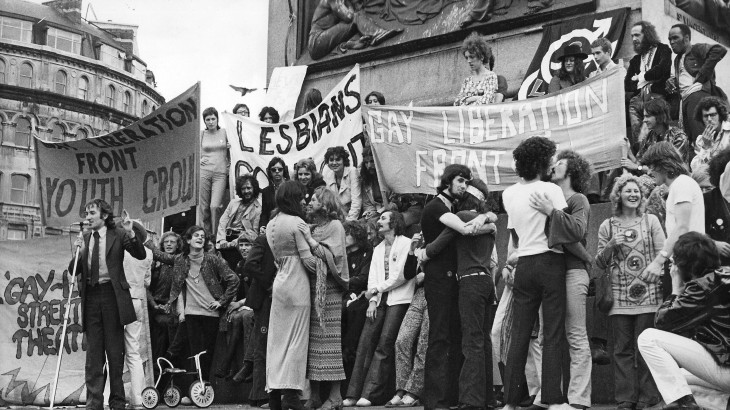GLF’s critique of orthodox masculinity & femininity is still valid
By Peter Tatchell
London, UK – 3 May 2016
On 13 October 1970, the Gay Liberation Front was founded in Britain. It proved to be a defining, watershed moment in UK queer history; changing forever lesbian, gay, bisexual and transgender (LGBT) consciousness.
I was lucky to be a part of GLF – a glorious mix of anarchists, hippies, left-wingers, feminists, liberals and counter-culturalists. Despite our differences, we shared a radical idealism – a dream of what the world could and should be – free from not just homophobia but the whole sex-shame culture, which oppressed straights as much as LGBTs. We were sexual liberationists and social revolutionaries, out to turn the world upside down.
GLF espoused a non-violent revolution in cultural values and attitudes. It questioned gender roles and patriarchy; going much further than merely condemning violations of LGBT civil rights and campaigning for equal treatment. Revolutionary not reformist, one of our main goals was to end the “male chauvinism” and “gender system” that underpinned much of the oppression LGBTs experienced.
We saw the persecution of queers as a consequence, at least in part, of the way many LGBT people deviated from the socially-prescribed gender roles of traditional masculinity and femininity. According to the orthodoxy of millennia, men were expected to act masculine and desire women. Women were supposed to be feminine and be attracted to men.
We queers subverted this conventional gender system. Gay men love other men and many of us are deemed inadequately macho. Lesbians love other women and tend to be less passive and dependent on men than many of their heterosexual sisters. Queer males don’t have to sexually possess women and female queers have no need for men to fulfil their erotic and emotional needs.
This is a part of the reason why we’ve been persecuted for centuries. Our nonconformity threatened the gender system which has, historically, sustained the social hegemony of male heterosexuality and misogyny – and of homophobia, biphobia and transphobia.
GLF positively celebrated queer deviance. We said the right to be LGBT includes the right to disobey straight gender norms. We singled out macho heterosexual masculinity, with its long tradition of domination and aggression, as the main oppressor of LGBTs and women. While not condemning all straight men, we saw sexist, homophobic straight males as a major roadblock to women’s and LGBT emancipation. This is why GLF allied closely with the women’s liberation movement.
The “radical drag” and ”gender-bender” politics of GLF sought to redefine maleness and renounce male power. Its female counterpart was equally gender subversive. These were conscious attempts to reject the oppressiveness and privilege of orthodox masculinity and to undermine the way it functioned to buttress the subordination of women and LGBTs.
The dissolution of straight male machismo was, we argued, one key way to erode LGBT and female oppression. True human liberation could only be achieved by breaking down the rigidity of the gender system and ending the tyranny whereby men and women were pressured to conform to rigid gender expectations. This gender role transformation was necessary to allow gender-variant people – both LGBT and straight – to live their lives freely, without stigma or shame.
We embraced the feminist and trans challenge to the notion that biology is destiny and that males and females were supposed to think and act in gender-defined ways. In our view, gender conformism was boring, suffocating and oppressive.
In contrast to the gay law reform movement, GLF’s strategy for queer emancipation was to change society’s values and norms, rather than adapt to them or seek equality within them. We sought a cultural revolution to overturn centuries of male heterosexual domination and thereby free both queers and women.
Nearly half a century on, GLF’s gender agenda has been partly won. Male and female roles are, today, less prescribed and inflexible than in 1970. There’s greater sexual fluidity and gender variance is more accepted. Butch women and fem men – whether homo or hetero – are still less often held up as social icons but they are also less likely to be demonised and outcast. Girlish boys and boyish girls don’t get victimised as much as in times past. Trans people are increasingly visible and embraced. LGBT kids frequently now come out at the age of 12 or 14. While many are bullied, many others are not. The acceptance of sexual and gender diversity is growing. The women and men of GLF trail-blazed a social revolution. Bravo!

